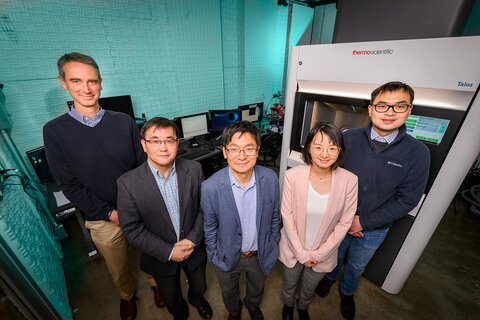By Lois Yoksoulian, Illinois News Bureau
To design better rechargeable ion batteries, engineers and chemists from the University of Illinois Urbana-Champaign collaborated to combine a powerful new electron microscopy technique and data mining to visually pinpoint areas of chemical and physical alteration within ion batteries.
A study led by Qian Chen, a professor of materials science and engineering and chemistry, and Jian-Min Zuo, who is also a materials science and engineering professor, is the first to map out altered domains inside rechargeable ion batteries at the nanoscale – a 10-fold or more increase in resolution over current X-ray and optical methods.
The findings are published in the journal Nature Materials.
The team said previous efforts to understand the working and failure mechanisms of battery materials have primarily focused on the chemical effect of recharging cycles, namely the changes in the chemical composition of the battery electrodes.
A new electron microscopy technique, called four-dimensional scanning transmission electron microscopy, allows the team to use a highly focused probe to collect images of the inner workings of batteries.
“During the operation of rechargeable ion batteries, ions diffuse in and out of the electrodes, causing mechanical strain and sometimes cracking failures,” said postdoctoral researcher and first author Wenxiang Chen. “Using the new electron microscopy method, we can capture the strain-caused nanoscale domains inside battery materials for the first time.”
Qian Chen said these types of microstructural heterogeneity transformations have been widely studied in ceramics and metallurgy but have not been used in energy storage materials until this study.
“The 4D-STEM method is critical to map otherwise inaccessible variations of crystallinity and domain orientations inside the materials,” Zuo said.
The team compared its 4D-STEM observations to computational modeling led by mechanical science and engineering professor Elif Ertekin to spot these variations.
“The combined data mining and 4D-STEM data show a pattern of nucleation, growth and coalescence process inside the batteries as the strained nanoscale domains develop,” Qian Chen said. “These patterns were further verified using X-ray diffraction data collected by materials science and engineering professor and study co-author Daniel Shoemaker.”
Qian Chen plans to further this research by creating movies of this process – something for which her lab is well known.
“The impact of this research can go beyond the multivalent ion battery system studied here,” said Paul Braun, a materials science and engineering professor, Materials Research Laboratory director and co-author of the study. “The concept, principles and the enabling characterization framework apply to electrodes in a variety of Li-ion and post-Li-ion batteries and other electrochemical systems including fuel cells, synaptic transistors and electrochromics.”
Illinois researchers Andrew Gewirth, of chemistry; Hong Yang, of chemical and biomolecular engineering; and Shell researcher Ryan Stephens also participated in this study.
Editor’s notes:
To reach Qian Chen, call 217-300-1137; email qchen20@illinois.edu
The paper “Formation and impact of nanoscopic oriented phase domains in electrochemical crystalline electrodes” is available online and from the U. of I. News Bureau. DOI: 10.1038/s41563-022-01381-4

